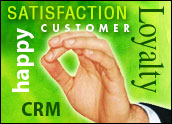
A trigger is a device that automatically executes a response to a certain event. In marketing, triggers are used to automatically deliver targeted messages, offers, recommendations or other treatments to customers on an individual basis at the most optimal point in time, based on any number of factors.
A growing number of chief marketing officers are coming to recognize the value of trigger marketing, which can result in a 3x, 5x or even 10x improvement in marketing campaign performance, if their anticipated marketing spends are any indication. According to the Aberdeen benchmark report Trigger Marketing: Timing Is Everything (now available for complimentary download), two-thirds of survey respondents have increased their budgets this year for customer data management and analytics technologies. These technologies provide the foundation for launching trigger marketing campaigns.
The reasons have everything to do with precision marketing effectiveness, cross-sell and upsell effectiveness and customer profitability. Consider the following:
- Precision marketing effectiveness. To win the attention of customers who are inundated with marketing messages and offers and who suffer from what industry pundits commonly refer to as “marketing fatigue” is no easy task. When used effectively, precision marketing, which in its broadest sense simply means leveraging customer data to present customers with more relevant messages and offers, allows companies to cut through the clutter to elicit a higher-than-average rate of positive customer responses in any given marketing program.
- Cross-sell and up-sell effectiveness. Often the direct result of precision marketing activities, companies are becoming increasingly adept at harnessing the power of customer analytics to sell additional products or services to existing customers. The key to success is relevancy and context. Cross-sell and up-sell effectiveness is largely a function of first gaining a sufficiently deep understanding of a customer’s unmet wants, needs, situations and preferences.
- Customer profitability. Precision marketing and cross-sell effectiveness should ultimately translate into increased customer profitability, which is commonly defined as the difference between the revenues earned from, and the costs associated with, a customer relationship over a specific period of time. A customer becomes profitable when the value the company derives from that individual exceeds the costs associated with attracting, selling and servicing him or her.
Types of Triggers
Marketing triggers are applicable across all stages of the customer lifecycle. “There are a large number of events that companies can observe that have marketing implications in terms of customer acquisition, customer retention and sales opportunities,” says Arie Goldshlager, Group Vice President, SunTrust Banks. Yet there are multiple perspectives on what qualifies as a marketing trigger and also no universal agreement on how many categories exist, let alone how these categories should be labeled.
The following are six categories, several of them overlapping, that speak to some of the most common types of marketing triggers.
- Customer life stage triggers. Customer life events can have major marketing implications. Such events might include a birthday, a new baby, a new car purchase, a change in marital status, becoming empty nesters and retirement. Detecting a home purchase based on new mover data, an insurance company might offer not only home insurance but also bundled services from home security, home telecommunications and other partners.
- Transaction behavioral triggers. Changes in purchase patterns, as well as changes in spending or account deposits, can speak volumes about a consumer’s future purchase intent. A credit card issuer can look at a customer’s transactions in certain merchant categories and determine that he or she is engaged in home improvement, travel planning or other activities that indicate marketing opportunities. A bank can learn a great deal from checking account transactions. Just knowing if a customer is cash flow positive or negative can determine whether he or she is a better candidate for a saving or a lending account. A retailer can understand what merchandise to promote next, and when, based on a customer’s recent purchases as well as frequent purchase combinations made by other customers in that same segment.
- Online behavioral triggers. Web site browsing patterns, requests for information, landing page interactions, etc., can tell a lot about a consumer’s wants, needs and interests and allow a company to serve up right-time messages. Determining where a consumer is in terms of their decision-making process, companies can engage a consumer in a relevant conversation that’s all the more likely to elicit a positive response. Companies that can detect when consumers are proactively searching for a new car, based on search terms, and click-throughs, can use triggers to automatically serve up a 0-percent financing offer or directions to the nearest dealer lot for a test drive.
- Expiration triggers. Products and promotions often have expiration dates which can be used to trigger an appropriate marketing action. In financial services, certificates of deposit, consumer loans and various other products have a maturity date that can be used to signal a context-sensitive offer or message from a lending institution or partner company.
- Credit bureau triggers. Banks monitor customers from the consumer lending perspective using credit bureau data. Information about credit card accounts, mortgage accounts, car loan accounts and even changes to a credit score can be used to trigger relevant responses. If a customer has a mortgage with a bank and the bank sees that the customer is making credit bureau inquiries, then that tells the bank that he or she is actively looking for other credit lending solutions. In that case, a trigger response might initiate a customer loyalty conversation that might involve, for example, an offer for promotional pricing. Monitoring and identifying events in credit bureau data has significant implication from both the customer retention and sales perspectives.
- External triggers. We live in a dynamic economy and business environment. External triggers are tied to such factors as changes in market conditions and competitive activity.
Best Buy and Discover Show How It’s Done
Competitive growth and profitability will always be top-of-mind for senior marketing executives, no matter the current state of the economy. And customer data quality — and customer data management, in general — will continue to be seen as a key part of the solution so far that it lays the groundwork for executing effective customer acquisition, retention, and cross-sell / up-sell programs. These programs require that companies understand the opportunities for marketing relevant products and services as well as the wants, needs, situations, preferences and potential value of prospects and customers on an individual basis to be able to determine their propensity to respond to a given message or offer.
Two companies that understand marketing triggers better than most are Best Buy and Discover Financial Services. Both leaders in their respective industries, these companies are extremely sophisticated when it comes to analyzing and acting upon customer data to drive business growth and profitability.
For Best Buy, acting upon customer data means, in part, serving up highly relevant marketing messages, store recommendations and product offers by utilizing event triggers tied to individual customer behavior. According to Matt Smith, Vice President of Financial Services Marketing, trigger marketing provides a marked improvement over traditional targeting mechanisms. “At Best Buy, we’ve had sales-to-ad ratios as high as 10-times when we start using triggers,” he says. “We’ve had a great deal of success with particular triggers in relatively narrow product bands.”
Best Buy uses a robust database that interlaces customer transaction histories to enable trigger marketing. Advanced analytics are used to reveal meaningful patterns in the data, while a CRM solution makes it possible to manage all of the database extracts. “Four years ago, we we’re doing about 50 data pulls a month to drive marketing campaigns,” says Smith, meaning the company pushed direct mail or e-mail offers 50 times a month. Today the company does so more than 800 times a month. “Keeping all of those streams of communications clear and allowing customers to communicate in some but not others becomes a very complex issue,” he says.
Best Buy is now focused on creating the vehicles and access to offers whereby customers themselves can pull the information they need. “The idea is to make a range of offers available to the consumer filtered based upon activity so, in a sense, triggered,” says Smith.
Of course, trigger marketing is not applicable to every customer purchase. Once a customer builds a computer network, for example, he or she likely won’t need another one for a while. The same is true for durable goods like a washer and dryer or even a home theater. “Once we have enough data to recognize you to trigger, you’re actually done building out the solution,” says Smith. “Most of the time, you’re going to replace the solution typically because it’s not meeting some need you have, and often that’s a break-fix need. We don’t have a lot of ways to get advance warning of that.”
Non-traditional data, including Web navigation clickstream data, holds some promise. Best Buy is trying to push as much of this data to the sales associates as a fulfillment vehicle for triggered offers. The goal is for so-called “blue shirts” to connect customers to relevant offers available in the moment through online, in the store, a store kiosk, and through offers that are available locally.
For Discover, which operates in an extremely data-rich industry, trigger marketing is a core capability and strategic imperative. As much as possible, the company has to understand each customer’s decision-making process with respect to their need for credit and how their use of related products shifts over time.
“We have a high-intensive relationship with our customers,” says Margo Georgiadis, the chief marketing officer. “In many cases, they’re using our products multiple times per week, and our products encompass so much of their lives that it gives us lots of opportunities to understand ways in which we can become more relevant and trigger-focused.”
Discover analyzes data in a myriad of ways to enhance customer relationships and drive increased profitability. Indicators of an opportunity frequently correlate with shifts in a pattern of how customers use a product or interruptions of historical patterns. “It’s important that consumers view the services you offer them as relevant,” says Georgiadis. If a customer takes step A, what is step B? A big purchase might trigger an offer for a paydown planner, for example, while a recent consolidation of account balances might trigger an offer for a balance management tool. A cash-back bonus bank that has reached a specific level might trigger a different communication, depending on whether the customer fits a certain profile.
“We may know that a consumer will become a loyal user of a product after they’ve had five types of experiences,” says Georgiadis. “But, we don’t want to just push them to have those experiences. Pushing people to do things doesn’t always produce the right outcome.”
On the new accounts side, the question is also one of how to reach the right customer at the right time with the right offer. “We spend a lot of time analyzing bureau data and any other information we can glean. We’ve really enhanced our sophistication in terms of the freshness of data and our speed to market,” says Georgiadis.
Triggers drive many types of opportunities at Discover, not all of them involving sales growth. “For us, the key to the brand is rewards, account control and anything else that increases long-term loyalty,” says Georgiadis.
“Triggers become an increasing asset in terms of relevancy because triggers almost always work better than a generic contact,” she says. “Identifying a segment and sending them a message suggesting they do something will almost always underperform a trigger-based campaign that’s more relevant and timely to that activity.”
Timing is Everything
Lester Wunderman, the advertising executive widely considered to be the father of modern-day direct marketing, once remarked that marketers can always figure out what to sell, how to sell, and to whom to sell. What they often can’t figure out is when to sell.
Knowing when prospects and customers are in the market to buy a specific product or service without them explicitly stating their interest is nearly impossible. Or is it?
In fact, trigger marketing provides a way for companies to know, often in a real-time fashion, when customers are in the market to buy, and also a way for them to respond to that knowledge as quickly and as profitably as possible. In essence, it allows companies to become good listeners, to make sense of what they’re hearing, and to react in an automated way. Ultimately, trigger marketing facilitates a shift away from pitching goods and services and toward providing customer care and enhancing the overall customer experience.
Jeff Zabin is Research Fellow at the Aberdeen Group. He can be reached at [email protected].






















































Social CRM
See all Social CRM